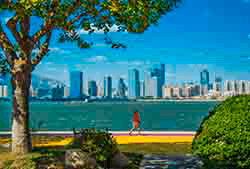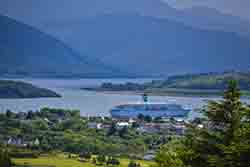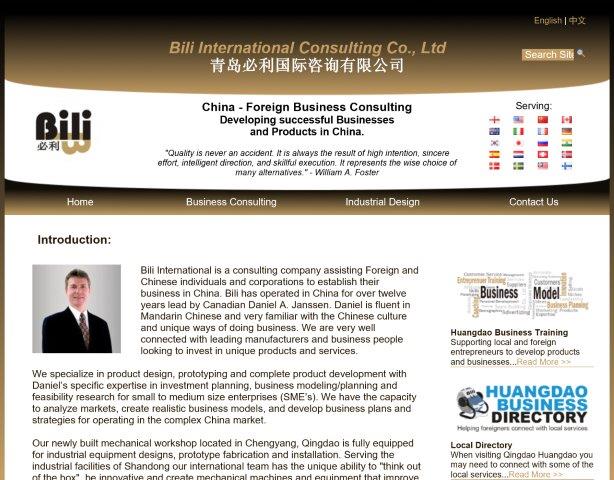MyHuangDao.com
A resource for foreigners that are living, working and or traveling from Qingdao or Huangdao, Shandong, China.

Thanks for visiting!
We are building the most comprehensive English based website to support foreigners living and working from this area. If you would like to be involved and/or cooperate in the development share your good ideas or offer products and services, please [contact us].
Serving:
About Shandong Province
The name Shandong is simply the pinyin for the Chinese characters山东. Shan meaning “Mountain” and Dong meaning “East” so you could translate literally as “East Mountain” or possibly better said “Mountains in the East”. (Pronunciation: Both characters are the first tone – Shāndōng.)
Another fact you will notice in this province is all the license plates of Shandong start with the Chinese character Lǔ (鲁) then a letter followed by numbers. Each letter following Lǔ (鲁) refers to a city in Shandong. The capital is Jinan so the plates is 鲁A, then cities in order of importance or size next being Qingdao鲁B, then Yantai鲁C and so on. This character is the short name for this province derived from the ancient times of Confucius day.
Shandong has a long and rich history of at least 5000 years of Chinese civilization and a much longer history with a recent find of one of the world’s largest sites of dinosaur bones. Shandong also has some important geological formations with the second longest river in China, the Yellow River (黄河) with a length of 5,464 kilometers, the Grand Canal as well as some significant mountain ranges that were significant for the development of many religions in the country including Chinese Buddhism, Taoism and Confucianism.
Let me take you through a brief tour of the history of Shandong and end with what has lead Shandong to be the most populous and richest provinces in China. The below information and references came from the articulate scholars Bai Shouyi and his book “An Outline History of China” and AnnPing Chin and her book “Confucius – A Life of Thought and Politics” and of course some references from Wikipedia and our personal experiences traveling throughout the province.
Cretaceous period – 145.5 to 65.5 million years ago:
In 1964 archeologists started digging in what turned out to be the largest collection of dinosaur bones in the world. In Shandong’s Zhucheng City there is a must see National Geo-Park exhibiting over 7600 dinosaur bones of Tyrannosaurus Rex, Ankylosaurus and the Ceratosaurus dinosaurs as well as many others. (See our Zhucheng Dinosaur Geo-Park page for more details.)
Longshan Culture – 5000 years ago:
The Lóngshān culture (龙山文化) meaning “Dragon Mountain” was a late Neolithic culture in China, centered on the central and lower Yellow River and dated from about 3000 BC to 2000 BC. The Longshan culture is named after the town of Longshan in the east part of Jinan the capital city of Shandong. According to Bai Shouyi approximately 5000 years ago the tribes of the Yellow and Yangtze River valleys entered into the era of patriarchal societies. The Chengziya Archaeological Site (城子崖遗址) is the location of the first discovery of the Neolithic Longshan Culture in 1928. The discovery of the Longshan Culture at Chengziya was a significant step towards understanding the origins of Chinese civilization.
Confucius – 2500 years ago:
Did you know Confucius was born in this province? Confucius was born in 551 BC in what was called the Spring and Autumn Period (771 – 481 BC) of the Zhou Dynasty (1045 – 221 BC). The country was divided into several regional states one of which was called Lǔ (鲁). Within that regional state was the place Confucius called home, now it is called Qufu. (曲阜) Qufu is a must see destination in Shandong and it is highly recommended to read up on Confucius prior to visiting. This will help better understand the history and some of the events taking place some 2500 years ago.
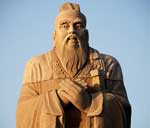
According to Bai Shouyi Confucius spent part of his youth as a low-ranking official managing warehouses. For the most part of his life however he was a private teacher and it has been said he had up to 3000 students. Not until his fifties did he become an official in charge of criminal punishment and the maintenance of social order in the state of Lu.
Confucius said “When I reach the age of fifty, I may try to understand the principles of change and I shall be able to steer clear of making serious mistakes”. Confucius was a gifted teacher and was so bold as to attempt a coherent teaching about what was virtue, who had worth, and what might be an ideal government. Annping Chin writes “It is still too early to tell whether the current Chinese government is trying to do the same in its call for a harmonious society and China’s peaceful rise in the global community”.
We do know that the students and people in Shandong, especially those of Qufu are more conscious and given more thought to Confucius than any other where else in China. Visit Qufu and experience the passion and explore the many sites dedicated to this historical man.
(See our Qufu page for more details about this city.)
Buddhism – 1600 years ago:
The modern province of Shandong was created by the Ming Dynasty which ruled for 276 years from 1368–1644.
German Occupation – 120 years ago:
In 1891 the Qing government began to improve Shandong Qingdao’s existing fortifications. German naval officials observed this activity and subsequently German troops seized and occupied the fortification. China conceded the area to Germany which existed from 1898 to 1914. Qingdao became the administrative center for the Germans. At that time Qingdao was nothing more than a village of fishermen and farmers. The Germans began to build and widened streets, built housing areas, government buildings, electrical infrastructure and a sewer system with safe drinking water supply. Commercial interests established the Qingdao Brewery in 1903 and began a range of other commercial enterprises.
During the First World War, China supported the Allies on condition that Germany’s concessions on the Shandong peninsula would be returned to China. The Treaty of Versailles transferred the German concessions in Shandong to Japan instead of restoring Chinese sovereignty over the area. Popular dissatisfaction with this outcome of the Treaty of Versailles led to the May Fourth Movement. Finally, Shandong reverted to Chinese control in 1922.
Boxer Rebellion – 115 years ago:
In 1898 Shandong was one of the first places in which the Boxer Rebellion started and became one of the centers of the uprising. The Boxers consisted of local farmers/peasants and other workers who were made desperate by disastrous floods and widespread opium addiction and laid the blame on Christian missionaries, Chinese Christians, and the Europeans colonizing their country. Missionaries were protected under the policy of extraterritoriality. Chinese Christians were alleged also to have filed false lawsuits. The Boxers called foreigners “Guizi” (鬼子, literally: demons), a term that condemned Chinese Christian converts and Chinese working for foreigners.
May Fourth Movement – 90 years ago:
The May Fourth Movement (五四运动) was an anti-imperialist, cultural, and political movement growing out of student demonstrations in Beijing on May 4, 1919, protesting the Chinese government’s response to the Treaty of Versailles, especially the Shandong Problem. These demonstrations sparked national protests and marked the upsurge of Chinese nationalism.
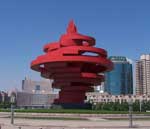
May 4th Square, Qingdao, Shandong
Then the Chinese delegation brought up the Shandong issue and asked for the return of the former German leased territories in Jiaozhou Bay, the Jiaozhou-Jinan Railway and other privileges directly to China. When World War I came to an end, the Chinese people, having long suffered from imperialist aggression and full of hopes for national independence, had hailed “the victory of truth over might” and the “14 Articles of Peace” put forward by the U.S. president Wilson. But the method of dealing with the Shandong issue at the Paris Peace Conference rid the Chinese people of their illusion and made them realize the need for themselves to “take direct action.” The May 4th Movement thus broke out.
On the afternoon of May 4, more than 3,000 students from 13 colleges and universities gathered in Tiananmen Square. Holding aloft banners, distributing leaflets and making speeches, they demanded “upholding China’s sovereignty,” “punishing traitors,” “abolishing the Twenty-one Demands,” “recovering Qingdao,” “refusing to sign the Paris Peace Treaty,” and “punishing the three pro-Japanese national traitors Cao Rulin, Zhang Zhongxiang and Lu Zongyu.”
The May 4th Movement was a patriotic political movement and a new cultural movement. The former began from May 4 to June 28, the latter from September 1915, when Chen Duxiu published the first issue of Qing nian za zhi (Youth Magazine), on July 1921, when the Communist Party of China was founded, lasting for 5 years and 10 months.
Today in Shandong:
From a rich history of peace, turmoil, revolution and transformation Shandong has risen to be the richest and most populated province in the country. Shandong covers and area of 156,700 sq/km and has a population of 95.8 million people (2010 Census). That is approximately three times the population of Canada in an area half the size of one of its major provinces.
Shandong is now an important historical, cultural and commercial hub in China. Rich in people, resources and commerce with a strong lighting industry including solar throughout the province, textiles, industrial products and machinery, automotive, high technology, agricultural industrial base, and now a burgeoning aviation industry in Binzhou that will make up to 200 planes per year for the European and American markets. Machine building has also grown in importance. The output value of the rubber industry ranks second in the country and its profit margins rank third. In the field of electronics and household electrical appliances, a series of high quality brand names like Haier, Hisense and Aucma all make Shandong’s Qingdao their home base.
Shandong Economic Stats:
GDP: 3.94 trillion RMB (2010 census)
Exports: 60.34 billion USD (2008)
Imports: 50.29 billion USD (2008)
Shandong tourism is a booming industry with several hundred kilometers of soft gold sand beaches from the north of the province down to the south. The beaches start on the north side of the province where the Yellow River pours into the Bohai Sea (渤海) and wraps around heading south along the Yellow Sea’s (黄河) coastline. The capital city Jinan (济南) hosts the Tourism Bureau of Shandong along with the Shandong Museum full of the rich culture and history of Shandong. (See their details at bottom of this article.) Closer to where I live Qingdao (青岛) is joining with Jiaonan (胶南) to develop northern China’s leading tourist resort area. Within this area you will find dozens of five star tourist resorts packed with theme parks, beaches, festivals, mountain trails, sandy beaches, eco and geological parks to visit.
And don’t forget about the beer! Shandong Qingdao is the head quarters and home town of the world famous Qingdao Beer or Tsingtao as it is spelt on the labels of the bottles. The brewery was constructed in 1903 and still remains to this day. There are brewery tours available and the Qingdao beer company hosts an annual beer festival in August. The beer festival is located in “Beer City” an area of several city blocks that is dedicated solely to this annual festival. There is lots of beer from around the world and fun for all ages with rides, games, and all kinds of entertainment.
(See our Qingdao page for more details about this brewery and city.)
Thank you for reading up on this historical province and we hope you find this website valuable to making your stay, your holidays and travels in Shandong safe, fun and full of exciting new ventures. Don’t forget to share this with a friend.
Sincerely, Daniel A. Janssen
Shandong Related Links:
Address: #17386 Jingshi Road, Jinan, Shandong, China
Shandong Tourism Service Hot Line: 12301
GPS Coordinates: 36.648623,117.034818
Shandong Tourism Information website: www.sdta.cn
Shandong Tourism Government Policy website: www.sdta.gov.cn
Shandong Museum
Address: #129 Jingshi Rd, Lixia District, Jinan, Shandong, China (2KM away from the east of Yanshan Bridge)
Consulting phone: 0531 – 85058202
GPS Coordinates: 36.649243,116.973232
Website: www.sdmuseum.com
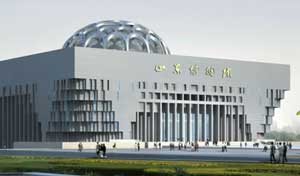
For a detailed Shandong Tourist Map click here!
If you want to get more information about shandong tourism places, please scan the QR Code by WeChat.
References:
- AnnPing Chin, “Confucius – A Life of Thought and Politics”. ISBN: 978-0-300-15118-3
- Bai Shouyi, “An Outline History of China”. ISBN: 7-119-02347-0
- China Business Handbook 2008
- Wikipedia, http://en.wikipedia.org/wiki/Shandong
- Wikipedia, http://en.wikipedia.org/wiki/Chengziya_Archaeological_Site
- WikiChina, http://wiki.china.org.cn/wiki/index.php/May_4th_Movement
And of course browse the rest of this site to find many unique and historical tourist and sightseeing destinations in this Friendly Province of Shandong!


